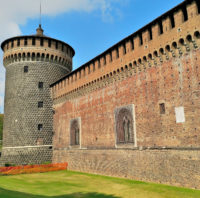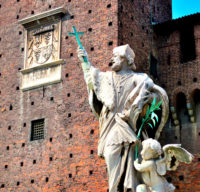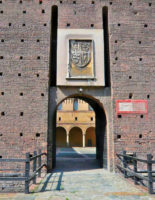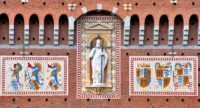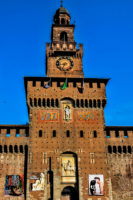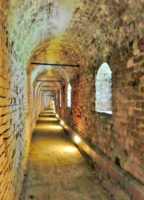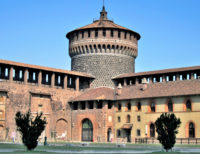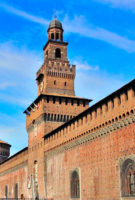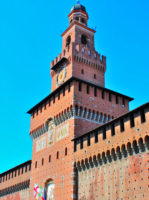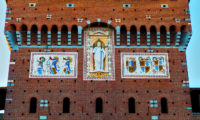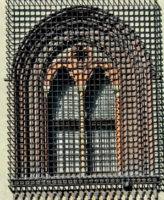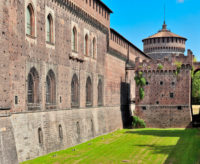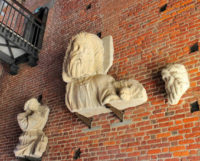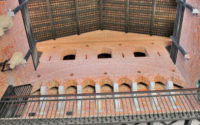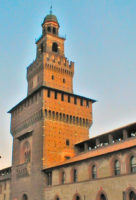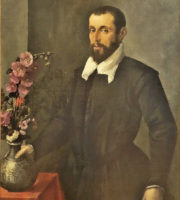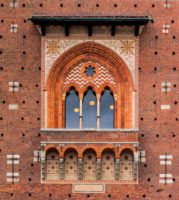What we see today is only a part of the original citadel which, at the beginning, consisted of other forts enclosed in a great star-shaped ramparted fortress. The perimetral development of the present quadrilateral, however, makes it Italy’s largest castle, and its construction would be the most beautiful of its kind had it not been subject to the injustice of time and men. But, even as it stands today, it is a majestic work, which hides behind its walls, extremely interesting Gothic-Renaissance halls and courtyards.
The castle was rebuilt in 1450 by Francesco Sforza on the ruins of the viscounty fort, which, in its turn, had been built on the ruins of the Porta Giovia castle which had been knocked down by the people during the “ Golden Ambrosian Republic ”. Under the rule of Lodovico Maria Sforza, known as the “ Moor ” (1495), the castle became one of the most important royal palaces, and the best known artists and architects of the time worked on it, among others Bramante and the great master Leonardo. On the death of Francesco II, the last of the Sforzas, its regal period came to an end and it became no more than a fortress. During the Spanish, French and Austrian dominations it was used as military barracks and underwent so much damage and rough treatment that it could only be considered little more than a ruin.
During the Napoleonic period a radical transformation was planned, so radical as to make it unrecognizable, and in 1859, with the defeat of the Austrians, it was used again as military’ barracks for the garrison troops. In 1890, when the troops were evacuated, it was decided to restore it, the job being given to the architect Luca Beltrami, who gave so much towards the saving of this famous monument. In 1893 the military authorities handed over the castle to the City, and so the transformation of the gloomy barracks into the present magnificent building, into the Archeological Museum, this is found in Corso Magenta. Other valuable archeological remains are to be found in the basements of houses in the historical centre of the city.
The barbaric raiders who invaded Italy during the course of the centuries, passed through Milan, plundering and destroying as they did so. The last destruction which it suffered were the 1943 bombing raids. From the ruins of Milan was built a greater and more industrial city, this was due to its talented and strong willed population. Milan was not the Longobard capital although it was the residence of Duke Albino, who had taken up court at the ” Curia Ducis ’’ where Cordusio now- stands, in fact the name of the square is derived from this court.
Charlemagne, king of the Franks, succeeded to the Longobard domination, but very few signs of this domination remain; a few ruins of the “Regio Ducale Palazzo” — also know as Arengo — remain of the Comunal period, these are incorporated into the Royal Palace, and the “Palazzo della Ragione” in Piazza Mercanti which was the commercial heart of medieval Milan.
The various stages of Milan’s history are bound up to the development of the city. From the time of the shortlived Torrianis period, to the Viscontis, to the Sforzas under Ludovico the Moor, right up to the sixteenth century when Milan was the heart of humanistic studies, and the Lombardic artistic Renaissance was at its height.
After the fall of the Sforzas, Milan fell under French, then Spanish and finallv, under Austrian domination. Under the rule of Mary Teresa of Austria, thanks to the stimulation of the Illuminists of Milan such as Beccaria, Verri and others, the organization of public administration became possible, this was done by creating the cadastre.
Then followed the Cisalpina Republic, follow-ed by Napoleon’s Italian Republic, and after the fall of Napoleon the Austrians returned. The year 1848, with its fatidical “Five Days’’, brought to Milan a short-lived moment of freedom which was to be followed by the worst period of Austrian domination. Only in 1859 did Milan and Lombardy cease to be under the domination of some foreign power.
Milan was, bv that time, the capital city of a kingdom, but it ceased to be independent and entered the nation as a city, to become an ever developing part of it.
From the fort courtyard one can go down into the underground archeological museum which contains some really interesting pieces. Here we can find a documentation of the ruin and reconstruction of the castle itself.
Since 1902 the ground floor rooms of the fort have housed the Historic Civic Archives. Since the war the seat has been enlarged and renewed, not only the rooms but other plants have been modernized and put in working order. The preserved documents date back to 1385 and go up to the XIXth. century, some even to 1927. The Archive also contains many Portiani documents. The Trivulzian library, bought by the city in 1935 is also attached to the Civic Archives, this contains 40,000 volumes, 1,500 manuscripts and 130 illuminated manuscripts.
The Bertarelli print collection bears the name of its founder, who, by giving his precious collection donated the first and most valuable part. It is a collection of prints of all kinds, from the artistic to the most popular kind. It is the only institute of its kind in Italy which contains so much iconographical material, and writers and editors often turn to them for the illustration of books and magazines.


